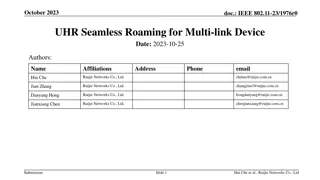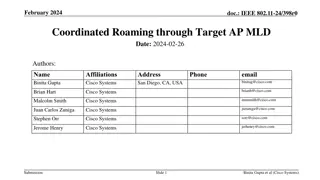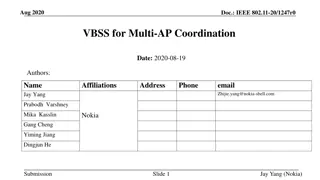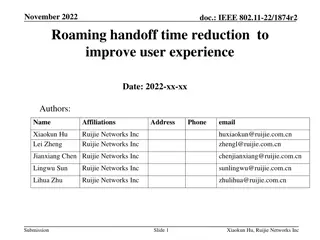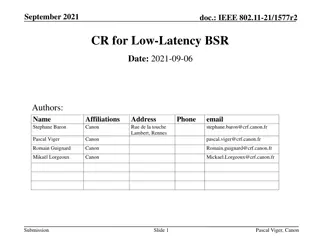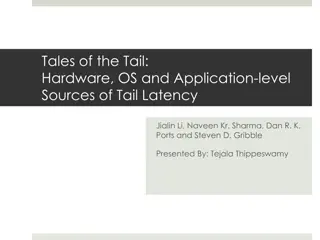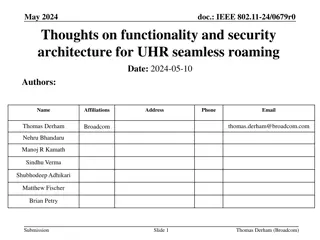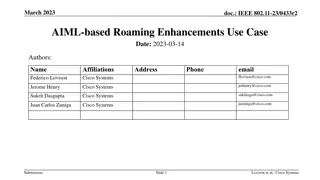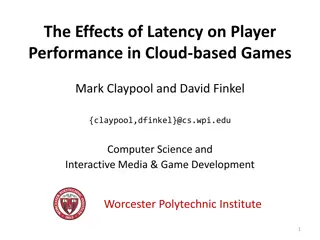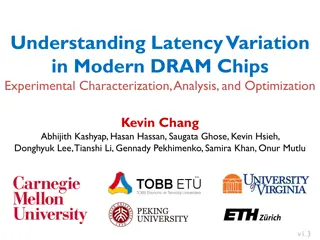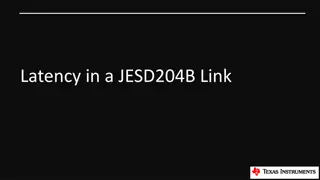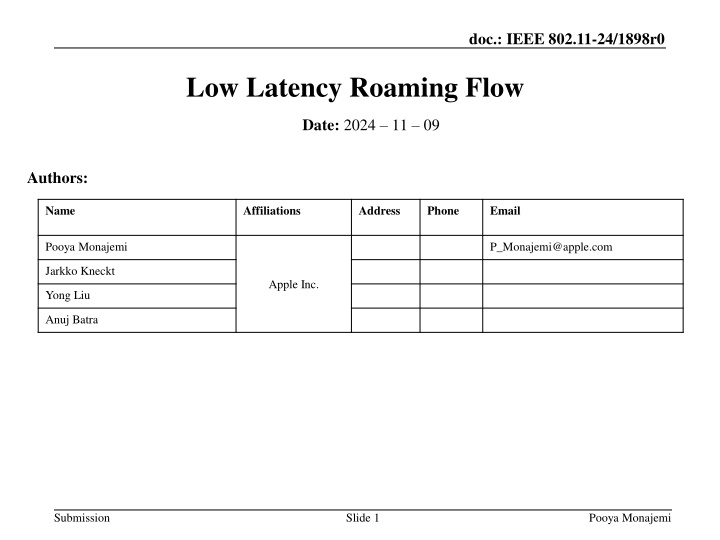
Optimizing Low Latency Roaming for IEEE 802.11-24 Networks
Delve into strategies for enhancing quality of experience in low latency applications during roaming events within IEEE 802.11-24 networks. Explore methods to minimize latency, eliminate packet loss, and optimize data flow to ensure seamless connectivity. Discover innovative approaches such as early context transfer and SN resets for efficient roaming.
Download Presentation

Please find below an Image/Link to download the presentation.
The content on the website is provided AS IS for your information and personal use only. It may not be sold, licensed, or shared on other websites without obtaining consent from the author. If you encounter any issues during the download, it is possible that the publisher has removed the file from their server.
You are allowed to download the files provided on this website for personal or commercial use, subject to the condition that they are used lawfully. All files are the property of their respective owners.
The content on the website is provided AS IS for your information and personal use only. It may not be sold, licensed, or shared on other websites without obtaining consent from the author.
E N D
Presentation Transcript
doc.: IEEE 802.11-24/1898r0 Low Latency Roaming Flow Date: 2024 11 09 Authors: Name Affiliations Address Phone Email Pooya Monajemi P_Monajemi@apple.com Jarkko Kneckt Apple Inc. Yong Liu Anuj Batra Submission Slide 1 Pooya Monajemi
doc.: IEEE 802.11-24/1898r0 Introduction In this submission, we advocate for maintaining quality of experience in low latency applications during a roam event, with the following goals: Minimizing latency including pause periods Minimizing/eliminating packet loss A request/response flow has been discussed in recent contributions We analyze potential cases that may introduce latency in data flow Main ideas Early semi-static context transfer in the background Reducing last-stage roaming latency by optionally eliminating sync requirements SN reset, to avoid last-SN sync between APs Submission Slide 2 Pooya Monajemi
doc.: IEEE 802.11-24/1898r0 A Single Exchange Flow Sequence Roam initiated by STA AP MLD1 (origin) triggers DL route switch AP MLD1 also initiates a context transfer to AP MLD2 (target) Once above steps are done AP MLD1 sends a Roam Ready signal to STA AP MLD1 meanwhile sends any buffered DL data to the STA STA needs to pause all UL traffic until the roam ready signal is received, then start UL with target AP MLD Concerns: UL pause can be prohibitively long for a low latency application AP-to-AP communication may be slow depending on architecture, medium, etc. A rejected or an undesirable Roam Ready response may cause an unnecessary delay in data while STA looks for another roaming target Submission Slide 3 Pooya Monajemi
doc.: IEEE 802.11-24/1898r0 Minimizing Roaming Latency Goal: Push as much of the process as possible to the background While data Rx/Tx continues with the origin AP MLD Links can be set up in the background Static context transfer can be performed in the background Static context is the set of parameters that do not change frequently Static context transfer may be combined with link setup process Dynamic context transfer can be optional UL likely still needs to be paused during the last roam request/response exchange STA can opt to eliminate the need for last-stage dynamic context transfer to shorten this duration SN values can be reset to 0 at the target AP (other BA parameters may be transferred) The need for PN sync can be also eliminated (details to be discussed in future) Submission Slide 4 Pooya Monajemi
doc.: IEEE 802.11-24/1898r0 Summary Presenting a flow for data path switch during roaming that can reduce latency caused by AP-to- AP sync Moving the AP-to-AP sync to background while DL/UL continue with origin AP Avoiding last-stage SN state sync by restarting the sequence numbers Submission Slide 5 Pooya Monajemi
doc.: IEEE 802.11-24/1898r0 Straw Poll 1 Do you support that in the roaming request, non-AP MLD can request not to transfer from the current AP MLD to the target AP MLD the following as part of the context transfer? - the next SN for existing DL BA agreement (TBD on whether it is per TID) - the latest SN that has been passed up for existing UL BA agreement (TBD on whether it is per TID) - The AP MLD shall accept the request Submission Slide 6 Pooya Monajemi

